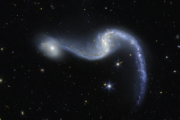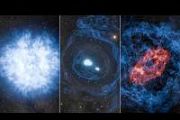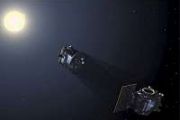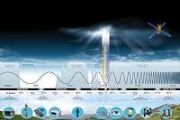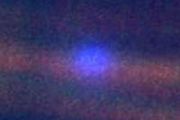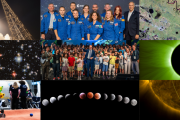
Copernical Team
Ariel takes shape and first shake
 Image:
Image:
The construction phase of ESA’s Ariel mission has started at Airbus Defence and Space in Toulouse (France) with the assembly of the spacecraft’s structural model. This marks a significant step forward for this mission designed to meticulously inspect the atmospheres of a thousand exoplanets and uncover their nature.
In the image we see Ariel’s structural model coming together at the Airbus facilities. This model replicates the mechanical framework of the spacecraft and the mass of its various units for a first round of tough testing.
The Ariel’s structural model consists of two main components: a flight-like replica of the service
LeoStella and BlackSky join SDA's Proliferated Low-Earth Orbit initiative
 LeoStella has been chosen by the Space Development Agency (SDA) to contribute to the Hybrid Acquisition for Proliferated Low-Earth Orbit (HALO) program. This initiative opens doors for nontraditional defense contractors to collaborate directly with SDA on rapid on-orbit mission feasibility prototypes. LeoStella, a small satellite manufacturer, will partner with BlackSky as a subcontractor to dev
LeoStella has been chosen by the Space Development Agency (SDA) to contribute to the Hybrid Acquisition for Proliferated Low-Earth Orbit (HALO) program. This initiative opens doors for nontraditional defense contractors to collaborate directly with SDA on rapid on-orbit mission feasibility prototypes. LeoStella, a small satellite manufacturer, will partner with BlackSky as a subcontractor to dev CATALYST introduces INSIGHTS 2.0 for smarter multi-source data visualization
 CATALYST, a PCI Geomatics Enterprise Inc. brand known for its leadership in Earth observation solutions, has launched INSIGHTS 2.0, a cutting-edge visualization platform that integrates and interprets data from multiple sources. INSIGHTS 2.0 is designed to enhance decision-making in critical sectors such as mining, wildfire management, and flood monitoring by fusing satellite imagery with ground
CATALYST, a PCI Geomatics Enterprise Inc. brand known for its leadership in Earth observation solutions, has launched INSIGHTS 2.0, a cutting-edge visualization platform that integrates and interprets data from multiple sources. INSIGHTS 2.0 is designed to enhance decision-making in critical sectors such as mining, wildfire management, and flood monitoring by fusing satellite imagery with ground NovaWurks joins SDA's HALO Program to Support Proliferated LEO Missions
 NovaWurks has announced its selection by the Space Development Agency (SDA) for participation in the Hybrid Acquisition for Proliferated LEO (HALO) pool. Through this program, NovaWurks will collaborate directly with the SDA, deploying its specialized spacecraft architecture in upcoming SDA mission profiles.
As a prime contractor, NovaWurks offers comprehensive mission support services, gu
NovaWurks has announced its selection by the Space Development Agency (SDA) for participation in the Hybrid Acquisition for Proliferated LEO (HALO) pool. Through this program, NovaWurks will collaborate directly with the SDA, deploying its specialized spacecraft architecture in upcoming SDA mission profiles.
As a prime contractor, NovaWurks offers comprehensive mission support services, gu UK to lead global EO group with ambitious focus on data and impact
 UK Space Agency Chief Executive Dr. Paul Bate has stepped into the role of Chair for the Committee on Earth Observation Satellites (CEOS), an international consortium dedicated to harmonizing Earth observation efforts from space.
As the new CEOS Chair, the UK aims to leverage Earth observation (EO) to benefit public services, inspire future leaders, and drive impactful global collaboration
UK Space Agency Chief Executive Dr. Paul Bate has stepped into the role of Chair for the Committee on Earth Observation Satellites (CEOS), an international consortium dedicated to harmonizing Earth observation efforts from space.
As the new CEOS Chair, the UK aims to leverage Earth observation (EO) to benefit public services, inspire future leaders, and drive impactful global collaboration Thin cool ocean surface enhances carbon absorption
 New research, funded in part by the European Space Agency (ESA), shows that the cool, thin layer at the ocean's surface - known as the "ocean skin" - allows oceans to absorb significantly more atmospheric carbon dioxide than previously estimated. This discovery could lead to more precise global carbon assessments and support better-informed emissions policies.
The world's oceans take in ab
New research, funded in part by the European Space Agency (ESA), shows that the cool, thin layer at the ocean's surface - known as the "ocean skin" - allows oceans to absorb significantly more atmospheric carbon dioxide than previously estimated. This discovery could lead to more precise global carbon assessments and support better-informed emissions policies.
The world's oceans take in ab EarthCARE mission highlights crucial roles of clouds and aerosols in atmospheric energy
 With the first images captured by the instruments on ESA's EarthCARE satellite, researchers are demonstrating how these advanced sensors work in synergy to analyze how clouds and aerosols impact Earth's heating and cooling. Presented at the International Astronautical Congress in Milan, Italy, these initial findings show the unique potential of EarthCARE's instrumentation to gather simultaneous
With the first images captured by the instruments on ESA's EarthCARE satellite, researchers are demonstrating how these advanced sensors work in synergy to analyze how clouds and aerosols impact Earth's heating and cooling. Presented at the International Astronautical Congress in Milan, Italy, these initial findings show the unique potential of EarthCARE's instrumentation to gather simultaneous Recent progress of Earth observation satellites in China
 Currently, there are 32 Earth observation satellites in orbit. Since 2022, China has launched nine new satellites, which are detailed in Table 1. This article explores recent advances in China's Earth observation satellite program, specifically satellite operations, data archiving, data distribution, and data coverage.
Researchers detail the recent additions of nine Earth observation sat
Currently, there are 32 Earth observation satellites in orbit. Since 2022, China has launched nine new satellites, which are detailed in Table 1. This article explores recent advances in China's Earth observation satellite program, specifically satellite operations, data archiving, data distribution, and data coverage.
Researchers detail the recent additions of nine Earth observation sat China's only woman spaceflight engineer in crew for 'dream' mission
 China's only woman spaceflight engineer will be among a crew of three astronauts blasting off on a "dream" mission to the Tiangong space station this week, Beijing announced Tuesday.
The new Tiangong team will carry out experiments with an eye to the space programme's ambitious goal of placing astronauts on the Moon by 2030 and eventually constructing a lunar base.
The Shenzhou-19 missio
China's only woman spaceflight engineer will be among a crew of three astronauts blasting off on a "dream" mission to the Tiangong space station this week, Beijing announced Tuesday.
The new Tiangong team will carry out experiments with an eye to the space programme's ambitious goal of placing astronauts on the Moon by 2030 and eventually constructing a lunar base.
The Shenzhou-19 missio China says it's ready to launch the next crew to its orbiting space station early Wednesday
This request seems a bit unusual, so we need to confirm that you're human. Please press and hold the button until it turns completely green. Thank you for your cooperation!
Press and hold the button
If you believe this is an error, please contact our support team.
185.132.36.159 : 18f3f05a-3faf-4b27-a008-ea52e561













